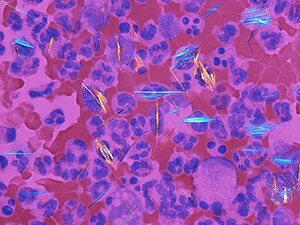Polarization

Crystals (gout) and blood cells in polarized light. (WC/Gabriel Caponetti)

Acquired cystic disease-associated renal cell carcinoma with non-polarized light and polarized light to highlight the oxylate crystals. H&E stain. (WC/Nephron)
Polarization, formally light polarization, in pathology refers to a technique used in light microscopy that makes use of polarized light.
Things that polarize
- Amyloid - apple-green birefringence.[1]
- Oxylate crystals - ethylene glycol poisoning,[2] acquired cystic disease-associated renal cell carcinoma, benign breast calcifications.[3]
- Gout crystals - negatively birefringent.[4]
- Pseudogout crystals - positively birefringent.[4]
See also
References
- ↑ Cornejo, KM.; Lagana, FJ.; Deng, A. (Nov 2015). "Nodular amyloidosis derived from keratinocytes: an unusual type of primary localized cutaneous nodular amyloidosis.". Am J Dermatopathol 37 (11): e129-33. doi:10.1097/DAD.0000000000000307. PMID 26485243.
- ↑ Rosano, TG.; Swift, TA.; Kranick, CJ.; Sikirica, M. (Oct 2009). "Ethylene glycol and glycolic acid in postmortem blood from fatal poisonings.". J Anal Toxicol 33 (8): 508-13. PMID 19874660.
- ↑ Ozer, E.; Canda, T.; Balci, P.; Gökçe, O.. "Calcium oxalate crystals in benign cyst fluid from the breast. A case report.". Acta Cytol 43 (2): 281-4. PMID 10097726.
- ↑ 4.0 4.1 Yeung, J.C.; Leonard, Blair J. N. (2005). The Toronto Notes 2005 - Review for the MCCQE and Comprehensive Medical Reference (2005 ed.). The Toronto Notes Inc. for Medical Students Inc.. pp. RH6. ISBN 978-0968592854.